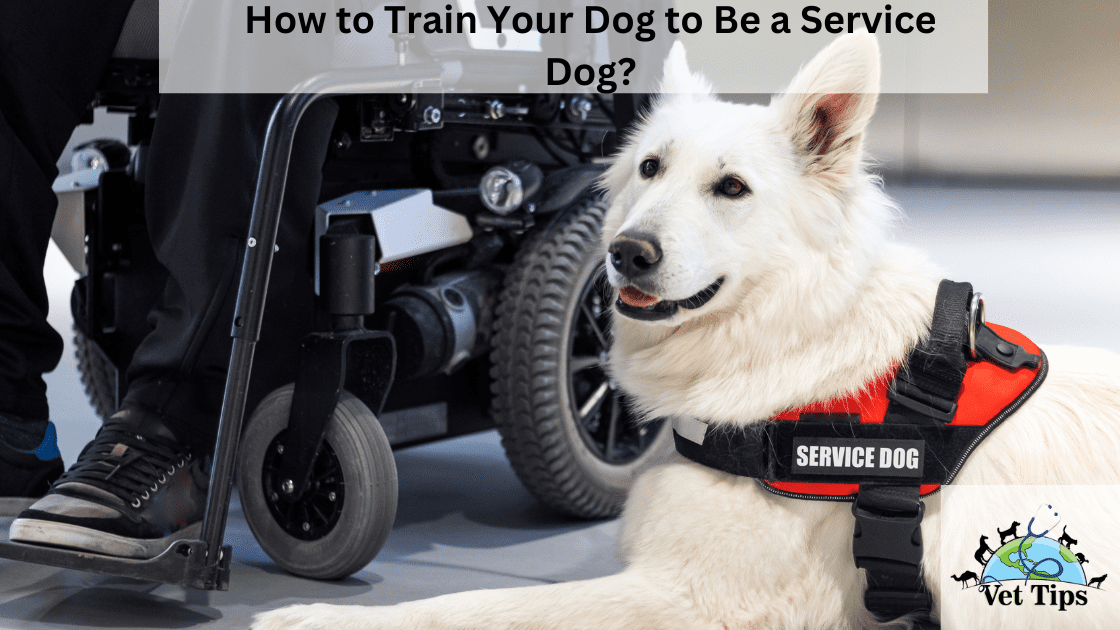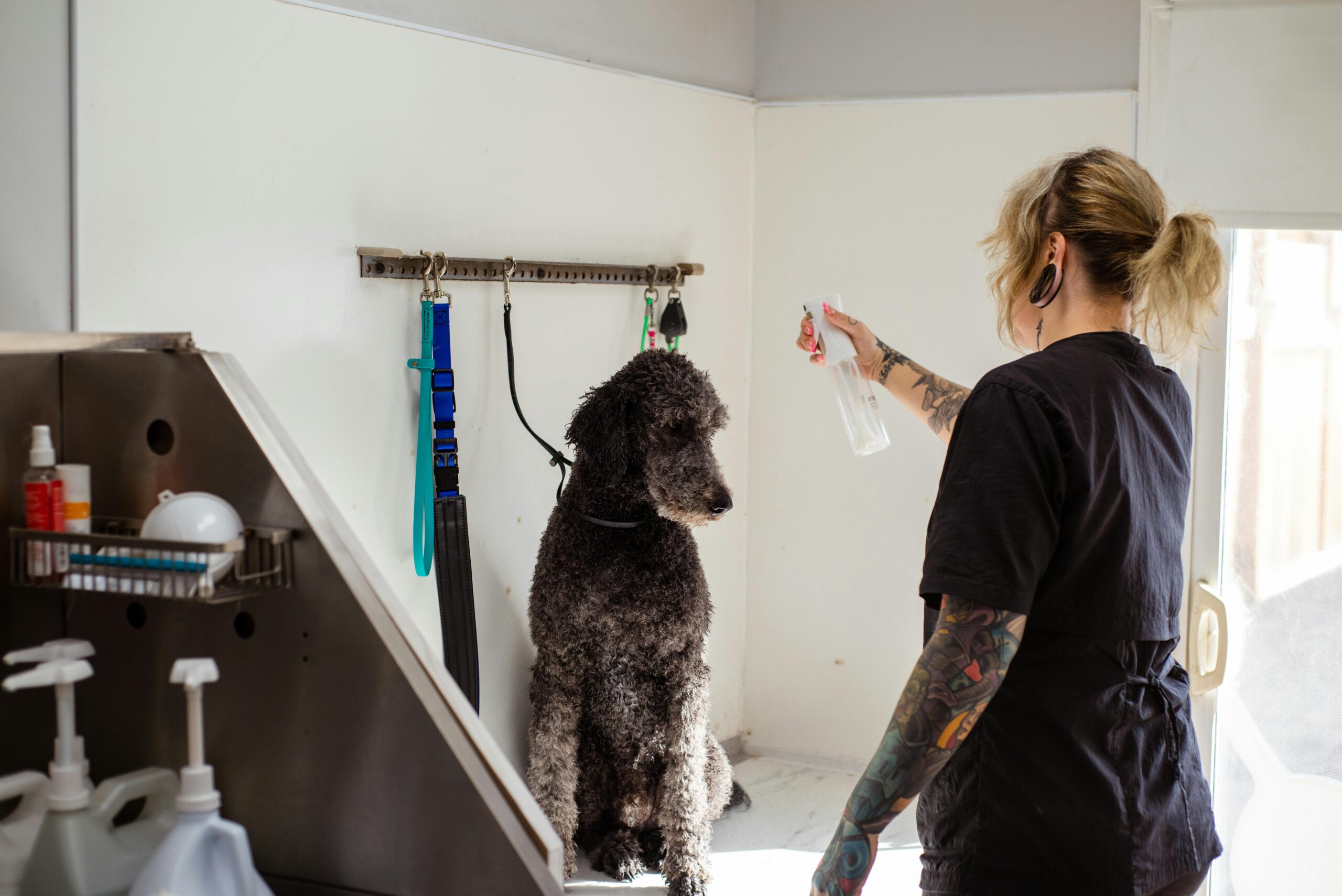Are you looking to turn your beloved canine companion into a service dog that can provide invaluable assistance and support? Well, you’ve come to the right place! In this comprehensive guide, we will delve into the intricacies of training your dog to become a skilled service dog. From understanding the main steps involved to offering real-life examples, we’ll cover everything you need to know on this exciting journey.
You must have heard the saying, “Company matters.” Well, dogs are the best companion and friends you could ever have. They add so much value to our lives and teach us how to love unconditionally. That adorable creature will do everything in its capacity just to please you. Their unique abilities to fulfill the command have encouraged many people for dog ownership. Oh yes, It’s trending!
You must be wondering why the number of ownerships has increased dramatically? Well, you must be surprised to know there are 80 million owners of dogs in the United States of America because of the benefits dogs are offering. Studies have shown us that your furry friends can be crucial to your health. Dogs can provide health benefits that are beyond your imagination. The free services you have enjoyed include increasing fitness by short walks in the morning and evening. Nature love will lower stress and will improve happiness by just keeping a dog.
A pet dog or a service dog?
A service dog assists human beings with their service to enjoy a better and more independent life. They provide excellent services to people with disabilities. Americans with Disabilities Act (ADA) states their perspective of a service dog. They say that a service dog is “the professionally trained dog to assist the people who have trouble having an independent life.”
Service dogs are an excellent choice you can make for a disabled person. Do you know what a disability is? “Disability” is losing the ability to enjoy daily life physically and mentally. It makes a person dependent on someone for their normal functioning. ADA has discouraged discrimination even if your major life activities have been impaired by offering help in every field of life, from transportation and employment to accommodations and communications. Consider service dogs a blessing and a chance to enjoy everyday healthy life and feel your life is nothing less than others. ADA considers service dog as a trained dog that is accepted as work dogs/professional dogs, not as pets.
When it comes to service dogs, training your dog is a bit different, and that service dog will help their owner in those respective manners. For example, you want to help a blind person, and guide dogs are what you are looking for. They will allow them to navigate their daily life. You want to help a deaf person, get them a hearing dog. You want to make a change to your friend having difficulty in moving, surprise them with a mobility dog this Christmas. They can help them walk their wheelchairs or any other walking devices.
Cont…
The wonders of service dogs will not cease to amaze you. You can even have Medical alert dogs for geriatric/ senior people. They are trained to respond quickly whenever there could be any medical emergency. They will alert the person for seizures, any allergen (allergic reactions), and even a drop in blood sugar levels. These all can be achieved by special dog behavior training. Sounds astonishing how they are saving lives!
Does health restrict itself only to physical problems? No, mental health is very significant for daily routine works. Can you ignore it? Suppose a person is suffering from an obsessive-compulsive disorder (OCD), schizophrenia, anxiety, Post Traumatic Stress Disorder (PTSD), and many other psychiatric problems. In that case, you should look for Psychiatric service dogs. Anxiety dog training is given to them to help people feel stress like a stream of light in the darkness. A ray of hope! They can help you break the monotony of repetitive behaviors and will help you remember to take medication on time. They will get you out of stress in no time. Bye Bye PTSD.
Therapy dogs receive therapy dog training and dog behavior training to help people in need. They mainly work voluntarily with the people who need affection, attention, and interaction. Wherever they are, they spread happiness. From a hospital ward to an exam hall, they relieve stress. They even help people with PTSD. ADA has still not approved them to be called precisely service dogs.
Did you know, courthouse dogs are also helping people with disabilities. Suppose any person with a disability needs to go into the courtroom. In that case, several states allow them to be accompanied by a dog. They even wear a vest and ID but are not recognized by ADA.
Service dog requirements
You must be wondering what the parameters or judging criteria would be for a dog to be called a service dog after service dog training. The following points will help you if you have a service dog.
- Only a person with a disability is eligible to have a service dog, a disability defined by ADA.
- The service dog must be of some assistance or trained for one disability.
- Service dogs must be an all-timed good-mannered dogs.
- Service dogs should identify accessories.
How can Your dog be a service dog?
Service dogs can be considered professional dogs. So, no profession can be followed without giving tests. Following are the steps to be followed to make your dog a service dog.
- Identify the type of your dog
- Train your dog with professional help or house training dog.
- Public access test must be passed
- Get certifications and registrations.
It is somewhat tricky but to help a disabled person, and your dog must pass it.
1. Understand what your dog type is:
What kind of breed or size of dog do you have? ADA highly discourages discrimination based on breed and size. Still, some breeds have been born with helping nature and are the easiest dogs to train, but they say every breed has its potential. From German shepherds, huskies, Bully Breeds, poodles to Labrador retrievers, every single one of them is capable enough to be trained to be service dogs. They just need to be directed and polished.
As they say, Never judge a book by its cover so, every breed of dog has unique features which might surprise you once trained. While identifying the characteristics of your dog, you should pay more attention to the characters they are born with or even to the characters they have acquired.
Size must be considered when you think of the task of training your dog. For example, a shi Tzu is not an excellent choice for moving wheelchairs. In comparison, Labrador retrievers and German shepherds can be the best guider dogs. Due to their small size, Poodles can be used for scent training and can be medical alert dogs. Identify your dog for health and fitness if they can help because of their age and health.
2. How to train a service dog?:
Training a service dog requires dedication, patience, and a structured approach. Begin by evaluating your dog’s temperament and abilities to ensure they possess the right qualities for service work. Look for traits like intelligence, obedience, focus, and a friendly disposition. If your dog is already well-behaved and has some basic training, it can be a great advantage in the training process.
Professional Training vs. Owner Training
Before diving into the training process, you might be wondering whether to seek professional assistance or take on the training yourself. Both options have their merits, and it largely depends on your dog’s individual needs and your experience as a handler.
Professional Training
Enlisting the help of professional trainers can be highly beneficial, especially if you lack experience or if your dog requires specialized training. Professional trainers possess expertise in identifying and honing specific skills, ensuring your dog becomes a well-rounded service dog.
Owner Training
On the other hand, owner training can create a unique bond between you and your dog. By taking on the responsibility yourself, you can tailor the training to suit your specific requirements. It also allows for greater flexibility and cost savings. However, remember that owner training demands consistency, time, and effort.
Main Steps in Training Your Service Dog
- Basic Obedience Training: Lay the foundation for your dog’s service training by teaching basic commands like sit, stay, heel, and come. This fundamental obedience will serve as the building blocks for more advanced tasks.
- Public Etiquette Training: A service dog must remain well-mannered and composed in public settings. Expose your dog to various environments, people, and other animals to ensure they remain focused and unphased.
- Task-Specific Training: Identify the tasks your service dog needs to perform based on your disability or medical condition. Whether it’s retrieving medication, guiding, or alerting, tailor the training accordingly.
- Distraction Training: Service dogs must stay focused even in distracting situations. Train your dog to remain attentive and undeterred, regardless of the surrounding distractions.
- Public Access Test (PAT): Most places require service dogs to pass a Public Access Test to ensure they are well-behaved and won’t disrupt public spaces. Preparing for and passing the PAT is crucial for your dog to be recognized as a legitimate service animal.
Real-Life Examples
Example 1: Guide Dogs for the Visually Impaired
Consider the case of Sarah, who lost her sight due to a medical condition. She underwent a rigorous training process with her dog, Max, to become her guide. Max learned to navigate Sarah safely through various obstacles, and the bond they developed was nothing short of extraordinary.
Example 2: Medical Alert Dog
Meet Mark, who suffers from epilepsy and experiences sudden seizures. His service dog, Luna, was trained to detect the subtle pre-seizure cues and alert Mark beforehand. This timely warning allows Mark to take necessary precautions and lead a more independent life.
Comparative Analysis
| Criteria | Professional Training | Owner Training |
|---|---|---|
| Cost | Higher cost due to professional fees and training facility charges. | Potentially lower cost, but might incur expenses for training resources. |
| Expertise | Trainers possess specialized knowledge and experience. | Owner needs to acquire knowledge or seek guidance from resources. |
| Flexibility | Strict schedule and structured approach. | Training can be customized based on dog’s needs and owner’s availability. |
| Bond with Dog | Interaction with trainers might not be as intimate. | Deepens the bond between owner and dog. |
| Task Specific Training | Trainers can focus on specific skills. | Owner can tailor training to meet individual needs. |
4. Public access test must be passed:
It is crucial in training that how your dog responds in public. Their public access tests must be passed. Here is the checklist that must be approved.
- Dog training for aggressive dogs is significant in passing the test as they must never be aggressive in public.
- Service dogs should be vigilant and not have any food cravings while on duty.
- The dog should have seized their hyper activities in public.
- How to train a dog not to bark in public over things is imperative to pass the test.
- They must not relieve themselves in public unless given command. Mini soldiers!
5. Certifications And Registrations:
You might not require a dog training certification if you are a U.S citizen. But a Service Dog ID card and service dog in the training vest will help your service dog move around and help the owner navigate easily. The registered service dogs will be allowed in confined office spaces, restaurants, hotels, and shopping malls without facing any problem.
Service Dog Toys
Had a long tiring day at the job today? You must want to relax yourself by watching TV or playing a video game. Your service dog might also need a break from a tiresome routine and might want to relax. Dog training treats are the best choice in such a scenario. There are four categories of toys:
Each one of them has a different function and is required at different times. Have a look:
Chew toys:
It’s part of being a dog’s innate need to chew on. Chewing is a stress-relieving activity for dogs because it stimulates their minds. Maintaining good dental hygiene and strong jaw muscles are two additional benefits of chewing.
A chew toy is an excellent stress reliever for service dogs, allowing them to remain happy and productive while on the job. It’s essential to consider your dog’s size and chewing habits when selecting a durable chew toy. Ideally, it should be a size that must not choke your mini soldier.
The material of the toy you chose for your dog’s chewing should be robust and flexible enough to sustain the dog’s aggressive chewing without harming his teeth. Smaller dogs and those who chew less aggressively may benefit from softer toys. Still, you should always choose with a high-quality toy made of durable materials that will not break down or be worn out over time, regardless of your dog’s breed or size.
Check out these best chew toys for your canine companion that easily help him in service dog training
Puzzle toys:
You must be thinking of engaging and intellective ways to play with your pet in its free time. Well, puzzle toys have the ability to keep your service dog engaged, motivated, and stimulated. A wide range of puzzle toys is available commercially. All of them are intended to keep your dog entertained and active.
There are numerous advantages to using puzzle toys with your service dog on a regular basis. Playing games helps to ease boredom as well as reduce anxiety. This means that your service dog will be happier and more active when it comes to their job. Start with a simple puzzle feeder to get your dog used to the concept. A toy that’s too difficult can keep your dog from becoming bored. To keep your service dog engaged, the IQ Reward Ball is a robust, non-toxic treat distributing puzzle toy.
It’s as simple as adding treats or kibble to the ball and letting your dog enjoy it. A small hole on one side of the ball allows rewards to be distributed while your dog tosses the ball around. Keeping your dog intellectually and physically active is a fantastic benefit.
Check out this best puzzle toy for your canine companion that easily helps him in service dog training.
Training toys:
Your service dog will benefit from using training toys like ropes and bite tugs to strengthen his body, boost his drive, teach him self-control and obedience, and improve basic dog training.
If you don’t keep control and teach your dog how to play appropriately, they may become aggressive. Consult a certified dog trainer if you’re doubtful of what to do. A well-chosen training toy can help your service dog burn off excess energy while it will also teach him new tricks.
To help pups and young dogs learn to bite and develop their drive, Dog Line’s Synthetic Linen or Jute Soft Bite Pillow is an excellent training aid. With three thick handles for a secure hold, this bag is made of tear-resistant, sturdy cloth that is put together with heavy-duty stitching.
Check out this best training toy for your canine companion that easily helps him in service dog training.
Chase toys:
Have you ever chased your dog? The answer must be yes. This is what they love the most, to be chased. Consider yourself lucky today as chase toys are an excellent physical and mental activity method.
Numerous chase toys are available, ranging from simple rubber balls to frisbees and slingshot-style devices. Flirt poles are one of the most practical types of chase toys for service dog exercise. They are easily accessible to those who have limited mobility.
Check out this best chase toy for your canine companion that easily helps him in service dog training.
Where and how to find a Service Dog for you?
Throughout the United States, professional service dog training companies and best dog training trainers who train dogs to be service dogs are required. They train dogs to do several skills unique to the owner’s impairment. It could be one single skill or a handful of skills. As part of their learning process, service dogs are taught to behave in public, including indoor and outdoor training. They are taught to calm down and keep everything under control in different circumstances.
Professional service dog trainers hold their canines to a high standard. There is a tremendous drop-out rate for service dog applicants, ranging from 50 percent to 70 percent. Fortunately, there are frequently lengthy waiting lists for dogs that do not make their way to show their eligibility.
Service dogs are trained by both non–profit and for-profit groups. It could give you a profit of $25,000. It includes everything from the start of training to monthly follow-up protocols to check reliability. Specific organizations supply service dogs free of charge to disabled individuals or even offer financial assistance to those who cannot afford a service dog but need one. Some may charge fully.
Individuals who need a service dog must not make any hasty decision but a wise one when choosing a dog. They must get one from a reputable center.
How to become a dog trainer of your service dog?
A person with a disability must have every right to train their service dog. No one can better know about their needs but themselves, and they should not be forced to get a professional trainer. Being calm in strange situations is essential for every service dog candidate. Few things your dog must have:
- Keep an eye on things but be calm in public.
- They must have a desire to please the owner.
- The ability to learn and retain information is required.
- Be able to adapt to a wide range of social circumstances and settings.
- Should have the ability to do the same task every day.
People who want to train their service dogs must start teaching them basic skills and then spend some time learning each other’s behaviors. House training that includes removing waste when instructed to do so is a good start. To socialize your dog, maintain a task in the presence of new persons, places, and smells. The dog must be taught to ignore distractions by obedience training with their owners as handlers. Dog obedience is achieved by dog obedience school who will use different dog obedience exercises.
Tell us in the comments, how you like our article “How to train your dog to be a service dog?”
For similar posts like this, click here.
For the source file, click here.





One thought on “How to Train Your Dog to Be a Service Dog?”